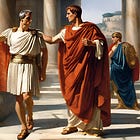Easter Is Not Pagan, and Neither Are Its Origins
Jesus is our Passover, and the events of one specific Passover week are the origin of the holiday, no matter how many Cadbury eggs you may consume.
This essay is free, but with Premium Membership you get MORE. Join today.
by Rod D. Martin
April 18, 2025
Every year, as Christians around the world celebrate Easter, skeptics revive a familiar claim: that Easter is just a repackaged pagan festival. They point to spring fertility rites, to goddesses like Ishtar and Eostre, and to symbols like eggs and rabbits, declaring Christianity guilty of cultural plagiarism.
But these assertions, repeated so often they’ve become clichés, collapse under any serious historical scrutiny. The truth is simple: Easter isn’t pagan, and neither are its origins. Rather, it is the central celebration of the Christian faith, grounded in real events, rooted in Jewish (not pagan) practice.
Perhaps some of the people who claim otherwise are simply used to distrusting authority (a good thing). A few may feel “superior” by asserting “hidden knowledge” (which is not at all a good thing: it’s pride, or gnosticism, or both).
But the truth is, even if Easter had all manner of pagan trappings (it does not), it wouldn’t matter: Christ came to conquer and redeem all things. That’s the whole point of the Resurrection: our Lord even conquered death! And Scripture tells us that it is indeed that Resurrection which is our hope, and that if it is not true then “we are to be the most pitied among men.” (1 Corinthians 15:17-19)
One online commenter suggested today that “nowhere does Scripture command us to celebrate Easter”. But if we need to be commanded to celebrate the Resurrection of our Redeemer, do we really believe at all?
Christmas was not “originally the Saturnalia”. Easter is not just a fertility rite. But it wouldn’t matter. Every knee, and everything, shall bow to Jesus Christ our risen Lord. “He is making all things new”, which means that previously they were old.
Still, let’s examine the evidence.
The Central Claim: Pagan Parallels
The argument that Easter is pagan generally takes two forms. First, critics claim that early Christians simply borrowed from pre-Christian fertility rites to make their new religion “more palatable” to the masses. Second, they argue that since many ancient religions had myths about dying and rising gods — Osiris, Tammuz, Mithras, or Dionysus — Christianity is just one more retelling of an old myth.
Both claims are superficial, historically ignorant, and logically incoherent. They also deny the faith.
Let’s start with the obvious: correlation does not equal causation. Why would we be surprised that pagans had holidays? Lots of them? Some overlapping with Christian ones?
Perhaps even more to the point, why should we be surprised to find Satan defiling actual holy days with his filth and lies?
Why should we let him get away with it? The critics seem to think that Satan and his pagan minions came first, not the Creator God.
The existence of seasonal festivals in spring, a time of agricultural rebirth, is neither surprising nor threatening to the claims of Christianity. Human societies, particularly agrarian ones, have always celebrated seasons. That some of these celebrations took place near the Jewish Passover — the actual historical setting of Jesus’ death and Resurrection — is coincidence, not conspiracy.
It’s just nonsense.
The Christian claim is not that Jesus symbolically rose like crops in the spring. The Christian claim is that Jesus physically, historically, rose from the dead in a specific week, on a specific day, in a specific city, under a specific Roman governor. Christianity is not a seasonal myth — it is an historical faith rooted in eyewitness testimony.
The Passover
What skeptics ignore — or never knew — is that Easter is rooted in the Jewish Passover. All four Gospels locate the death and Resurrection of Jesus during the Passover week. Jesus is repeatedly called the “Lamb of God,” a reference to the Passover lamb whose blood the Israelites in Egypt had placed as a sign on their doorposts, demonstrating their faith so the Lord would pass them over as He poured out judgment on their oppressors.
The Last Supper itself was a Passover meal. Paul, writing within twenty years of Jesus’ death, explicitly connects Christ’s Resurrection with Passover, calling Him “our Passover lamb” (1 Corinthians 5:7) and asserting that His Resurrection occurred “on the third day according to the Scriptures” (1 Corinthians 15:4) — a reference to the Hebrew Bible, not Babylonian, Egyptian, or Norse myth.
The earliest Christians, almost all of whom were Jewish, did not need pagan holidays to build their calendar. They already had one. And they tied the celebration of Christ’s Resurrection directly to Passover — its actual well-witnessed date — not to the vernal equinox or some fertility goddess. The very name of the celebration — Pascha — is the Greek and Latin word for Passover. To this day, most Christians around the world — Eastern Orthodox, Greek, Coptic, Syriac, Armenian, and many others — still call it Pascha or a local derivative (i.e., Pascua de Resurrección in Spanish, Pâques in French, Pasqua in Italian, Paşti in Romanian, Paskha in Russian).
The English word “Easter” is an historical outlier, not the norm.
So what About the Name “Easter”?
The etymological argument is one of the weakest — and most frequently cited — by critics. Many claim “Easter” comes from the Anglo-Saxon goddess Eostre, supposedly worshiped in springtime rites involving hares and fertility symbols.
The problem? This theory, popularized only very recently in the 19th-century by the monk Bede, rests on extremely thin evidence: a single passing reference in De Temporum Ratione, written around A.D. 725. No archaeological evidence, no liturgies, no myths, and no other textual sources mention this goddess at all, much less any celebrations tied to her.
But even if Bede was correct (and he wasn’t) that would prove only that English and German speakers used a local word for a Christian holiday. In German, Easter is Ostern. But again, in virtually every other major language the word used derives directly from “Passover”.
Christianity was not borrowing paganism. The English language, much later, was borrowing a Germanic word for spring.
It’s also worth noting that naming conventions prove nothing about the origin of the thing itself. The English days of the week are named for Norse gods: Thursday is “Thor’s day,” and Friday is “Frigg’s day.” But no one suggests Christianity is secretly worshiping Odin when we go to church on Sunday. Names change. Language evolves. Our God does not.
Dying and Rising Gods?
Another popular but equally flawed theory asserts that Christianity copied its central event — the Resurrection — from ancient myths about dying and rising gods. Osiris in Egypt, Tammuz in Mesopotamia, Dionysus in Greece — these figures are trotted out as supposed prototypes of Christ.
This is simply not something a Christian can believe. But it’s also not believable.
Each of these myths differ in substance, not just detail. Osiris dies and becomes king of the underworld, but he never returns to earthly life. Tammuz dies and returns cyclically, but there is no once-for-all Resurrection. Mithras doesn’t die at all in his myth. And Dionysus’ story involves dismemberment and rebirth in various tellings, none of which even vaguely resemble the Gospel narratives. And in any case, none of these myths make historical claims about a unique, bodily Resurrection in real space and time.
More importantly, the earliest Christian writings — especially Paul’s letters — show no trace of these myths. Paul was a rigorously monotheistic Jew and one of the leading theologians of his day even prior to his conversion. His letters are saturated with references to the Old Testament, not Greco-Roman mythology. His Christology is drawn from Isaiah, Ezekiel, and the Psalms — not from Isis or Ishtar.
If Christianity had borrowed from paganism, you would expect syncretism in its earliest texts. You would expect rituals, stories, or symbols that mirrored pagan cults. Instead, you find Jewish categories — Messiah, sacrifice, covenant, Resurrection — applied to a Jewish man crucified under Roman authority and afterward witnessed alive by hundreds.
The early church didn’t copy pagan myths. It upended them.
The Ishtar Myth: A False Internet Meme
One of the most viral claims about Easter is that it derives from the ancient Mesopotamian goddess Ishtar (pronounced Eesh-tar), a deity of fertility, love, war, and sex. A popular meme circulates every year, usually around Holy Week, declaring:
Easter is actually the celebration of Ishtar, the Assyrian and Babylonian goddess of fertility and sex... Her symbols (like the egg and the bunny) were and still are fertility and sex symbols... After Constantine decided to Christianize the Empire, Easter was changed to represent Jesus.
This meme is almost pure fiction.
For starters, there is no linguistic connection between Ishtar and Easter. The names sound vaguely similar in English, but they come from entirely different language families. Ishtar is Akkadian, derived from the Sumerian Inanna. Easter, as already noted, comes from the Old English Ēastre (or possibly Ēostre), a name mentioned in passing by Bede to describe a local spring festival. There is no historical or etymological link between the two.
Moreover, there is no evidence that Christians in the early centuries of the church ever associated Easter with Ishtar or with any rituals surrounding her. Nor are there any serious scholars who support this theory, whether Christian or otherwise.
The Ihstar “connection” is pure internet folklore, not academic history. Even secular scholars of ancient religion find this claim laughable. The meme conflates phonetic coincidence with historical causality — and ignores the deep Jewish foundation of Christian Resurrection theology.
So why do people believe it? Likely because it's catchy, subversive, and easy to share. But ease of repetition doesn’t make it true. Ishtar has no part in the origin of Easter, either in name or in meaning.
Eggs and Bunnies
Skeptics often point to Easter eggs and rabbits as “proof” of pagan influence. It’s true that eggs and rabbits have long been symbols of fertility in various cultures. But their use in Christian celebration developed much later — and they were not originally religious symbols at all.
Eggs were forbidden during Lent in the early Middle Ages, so when the fast ended, Christians feasted on them at Easter. Decorating eggs became a festive custom, not a theological statement. Similarly, the Easter bunny traces its origins to German folklore in the 1600s — not exactly a time known for its paganism — and did not become widely associated with Easter until the 19th century in America.
These customs are cultural, not creedal.
Cultural accretions around holidays are inevitable. That doesn’t mean the holiday is pagan. It means it’s popular. And in cultures shaped by Christian belief, that popularity grew around Christian truth.
The Historical Reality
Finally, and most importantly, the entire premise of the “Easter is pagan” argument ignores the historical claims of Christianity. The Gospels don’t tell us that Christ rose in the spring, like Persephone emerging from Hades. They tell us He rose on the third day, during a specific Passover, witnessed by real people who were willing to die for what they saw. This wasn’t a seasonal myth. It was a shocking, world-shattering event that transformed cowards into martyrs and a small Jewish sect into a global faith.
The early Christians didn’t celebrate the Resurrection because it fit the seasons. They celebrated it because they believed it had happened. And they marked that celebration not with rites to a forgotten goddess, but with hymns, baptisms, Scripture readings, and communion — the breaking of bread in remembrance of Christ’s body, and the cup in remembrance of His blood, He Who is our Passover (1 Corinthians 5:7).
Christianity conquered paganism not by imitation, but by contradiction. The early church grew because it refused to bow to the emperor, refused to offer incense to idols, and refused to reduce Jesus to just one more myth in the pantheon of dying gods. It proclaimed a risen Christ, victorious over sin and death, and it did so all too often at the cost of its own blood.
No, the Empty Tomb Is Not a Fertility Rite
Easter is not pagan. Its foundation is Jewish, its meaning is historical, and its message is uniquely Christian: that God has entered history, died in our place, and risen in triumph over the grave.
Attempts to tie Easter to pagan mythology fail not only historically, but theologically. They misunderstand the nature of the Christian claim and misrepresent the evidence that supports it.
If the Resurrection is true, no pagan myth can diminish it. And if it is false, then no pagan parallel can redeem it. But Christians don’t gather on Easter morning because of myths or metaphors. They gather because a tomb was empty — and still is.
That is not pagan. That is the Hope of the world.










The History of Easter
https://www.youtube.com/watch?v=saT8v0RrLl0
Mar 15, 2025 #Passover #EasterBunny #Ishtar
This video examines the historical origins of Easter, tracing its development from the Jewish Passover to its current form. Easter began over 2,000 years ago in Judea, rooted in the Jewish festival of Pesach, which commemorates the Israelites’ liberation from Egypt. Around 30–33 AD, Jesus of Nazareth’s crucifixion and resurrection during Passover became the foundation for the Christian celebration, initially called Pascha, meaning Passover in Greek. Early Christians, many of whom were Jews, linked Jesus’ death to the Passover lamb, shifting the focus from physical liberation to spiritual salvation.
Timestamps:
(Snip)
Cadbury Eggs One more poof thee is a God and he wants me to be happy. :-)